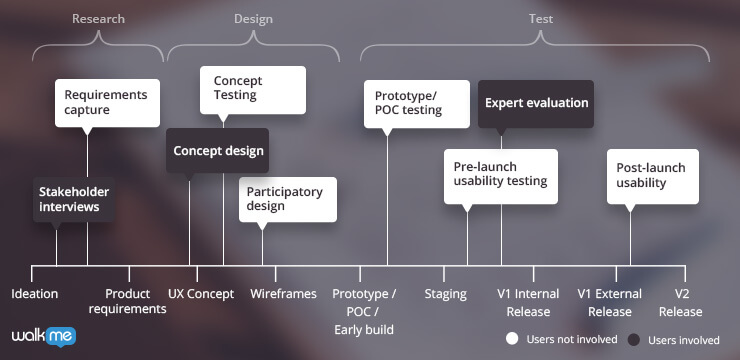We’re developing a feature that adds a new layer of customization that I’m not supposed to tell you about. So, let’s keep this between us.
We have a pressing deadline and huge aspirations.
Shipping a minimum viable product in a client-centered, B2B, SaaS environment still means shipping a quality product – and quality requires thorough user testing and making use of the feedback we receive. The more iterative the process, the better.
For this new feature, I have a short time-to-market, but in my favor, I happen to have access to users who sit across the hall from me. Knowing these factors, I can find a UX Combo that fits these specific constraints and gives me the maximum UX ROI.
Want to boost your UX? Let WalkMe help you.
What is a UX Combo?
A UX Combo is a set of UX methods selected for a given project, which can provide the best ROI for UX research, design and testing.
Within the given resource constraints, namely access to users and time-to-market, UX Combos are a holistic approach to look at your UX efforts.
If you’re thinking you missed the lecture on UX Combos, don’t worry. This is an idea that was developed by myself and the WalkMe team and is only now being shared with the public.
As the UX Lead at WalkMe, part of my job is to help product managers understand and get the most out of their options and resources.
I wanted an easy way to communicate to product managers that they have multiple options to choose from and that the diversity of methods gives them the flexibility to optimize their usage for each project’s specific constraints.
Choosing your UX methods at the beginning of the project is a critical part of the UX Combo approach. If you don’t plan ahead of time, you may as well not use the UX Combo approach.
Why? Deciding at the beginning of the project which UX methods you will pursue, will allow enough time to conduct each of the user experience methods properly. The main issues being:
- Getting users for sessions requires planning ahead
- WRT the feedback you get, you need time to digest, analyze, re-design, and build (and sometimes test again).
- If you plan in advance you can make sure users are involved in the optimal way (again, ROI)
With this approach, at the beginning of each project we now ask “What’s your UX Combo?” and have an instant and deep understanding of how we choose which UX methods are right for the project.
UX Methods are Grouped into 3 Stages on the Product Development Timeline
The first step for our team was to understand the relationship between the product timeline and the available qualitative user experience methods.
I’m mainly referring to the qualitative UX methods, since analyzing current user behavior data is less time sensitive and, sometimes, less relevant when you’re designing a new feature.
I’ve sketched out a general product timeline in Figure 1.
This timeline brings UX designers and product managers on the same page by placing the main qualitative methods that we can pursue on top of the timeline at which point they become relevant.
The methods are broken to two types: Those that involve users and those who don’t. The reason for this breakdown is to highlight the effort required to access users, and that your selection is very much dependent on that.
In high level, the UX methods are broken to three stages within the product/UX timeline:
- Research – Collecting requirements via stakeholders, users, competitors, etc.
- Design – UX Concepts and later on Wireframes
- Testing – Prototype testing, and usability testing (pre andpost-releasee)
Ideally, you would want to have at least one UX method incorporated from each of the three stages. This begins the feedback loop early which makes it possible for your final product to be in line with user needs from the beginning, and gives you additional opportunities to iterate and refine later on.
What you don’t want to do is have all feedback gathered in one stage. If you wait till the end, you are likely to have more to fix than if you had relevant input in the beginning. Having feedback only in the middle or beginning means you won’t have information on your final product.
UX Efforts are Constrained by Access to Users & Time-to-Market
The next step for our team was to ask which UX methods we should use, and even more importantly, which ones we can skip.
There are a lot of factors that can affect which methods you select such as your own confidence in facilitating the method, or to what extent your organization is risk averse.
However, at the end of the day we believe that the two factors that affect your decision most are: access-to-users and time-to-market.
B2B companies may find that it is exceedingly difficult to access users. You may want to run some in-context Requirements Capture (i.e. meeting users in their own work environment), but cannot afford flying there every time.
Or you may want to run both Concept Testing (early) and Usability Testing (post-launch) but the Account Managers may limit your access to their clients for business reasons.
Understanding that these two limitations will determine which UX methods are feasible within the planned product timeline, we then can quickly narrow down our options.
In Figure 2, you can see a matrix of suggested methods you can apply under your specific set of circumstances.
These are based on our own experience, and are suggestions only. You can obviously pick and choose as best fits your resources.
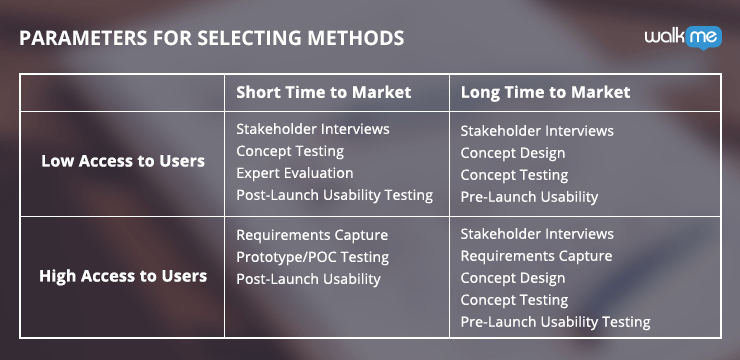
Now that we know which options are available, we can put them on the timeline.
A UX Combo is a Mix of Methods, Represented on the Timeline
Let’s see how this matrix lays out on the timeline and why.
High Access to Users, Short Time to Market
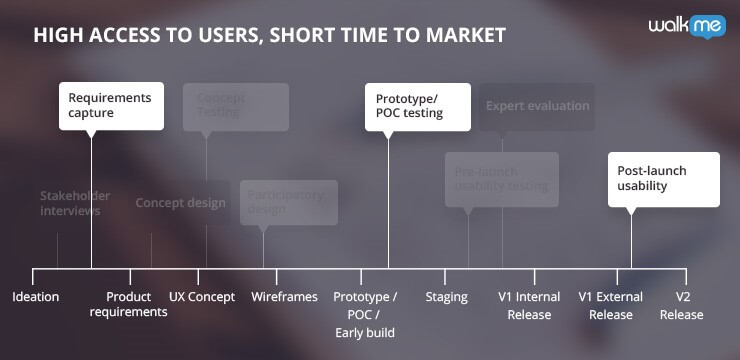
In Figure 3, we’re looking at ‘High Access to Users, Short Time to Market’ which, generally speaking, is the most frequent case here at WalkMe.
Fortunately, we have some of our heavy users internally. Our Professional Services team is only a couple of rooms away from us, meaning High Access, but we’re on a tight timeline to release.
In this case, I can squeeze in fairly easily the Requirement Capture AND Prototype Testing so I have two stages of user input. Based on these and if time presses, I should feel fairly comfortable to release the product and only test it after its launch, to minimize Time to Market.
High Access to Users, Long Time to Market
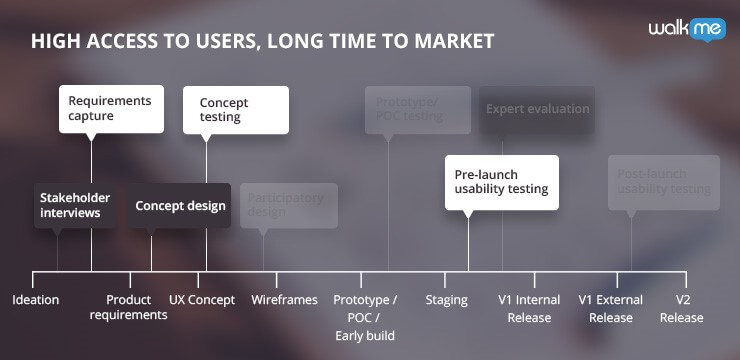
Alternatively, if I’m lucky enough to have more time I can spend more of it in the early stages, get a strong basis for my assumptions, and still run Usability Testing before launch. This is shown in Figure 4.
A different variation of the same approach can be achieved by replacing Concept Design and Concept Testing, with one of my favorites – Participatory Design.
Assuming you’re seasoned facilitator, the later involves a design workshop with the users so if users are happy with the outcome, you can skip the Concept Testing and move on towards build.
Low Access to Users, Long Time to Market
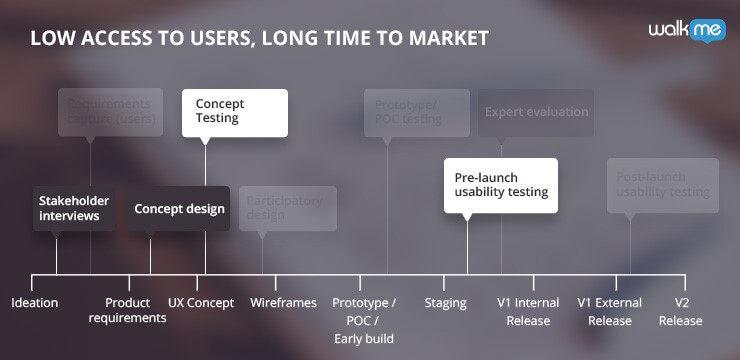
If getting access to users is harder but time-wise you’re comfortable, then you need to be frugal with your users.
In this scenario, shown in Figure 5, work independently with non-user methods and involve the users only twice: to confirm assumptions via Concept Testing and to test the real thing before it’s out.
Low Access to Users, Short Time to Market
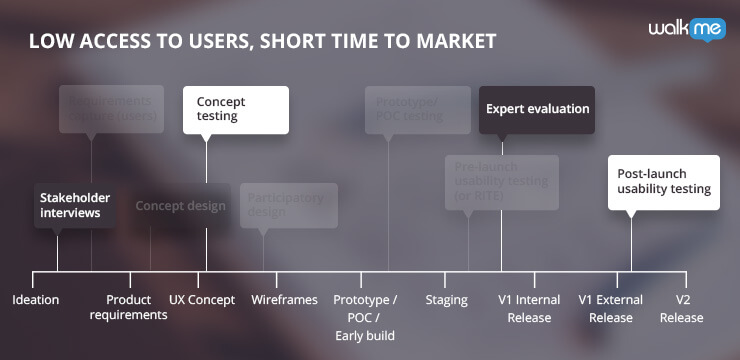
For the worst case scenario when you’re limited both with users and time, interview stakeholders, come up with concepts and test them with users. As you near launch, grab a colleague or a peer UX pro (hey, always good to have some UX friends) to run an Expert Evaluation.
Release the product and then run some Usability Testing, post-launch, as seen in Figure 6.
So what are you waiting for? Perfect your UX now with WalkMe’s help.
Explore Each UX Combo in Depth
I’ve broken down each UX Combo and the UX methods for each one. Use these four guides to help you plan your UX research methods:
Part 1: UX Methods for a Short Time to Market and Low Access to Users
Part 2: UX Methods for a Long Time to Market and High Access to Users
Part 3: UX Methods for a Short Time to Market and High Access to Users
Part 4: UX Methods for a Long Time to Market and Low Access to Users


